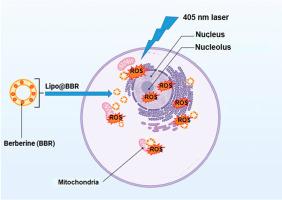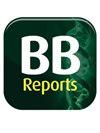小檗碱脂质体纳米颗粒在 A549 肺癌球形细胞光动力疗法中的应用
IF 2.3
Q3 BIOCHEMISTRY & MOLECULAR BIOLOGY
引用次数: 0
摘要
脂质体的应用是一种重要的给药策略,可增加细胞对水溶性低的药物的吸收。小檗碱(BBR)是一种生物活性化合物,存在于多种植物中,包括金线莲、小檗和俄勒冈葡萄。小檗碱具有多种健康益处,尤其是在新陈代谢健康和抗菌活性方面,因此备受关注。然而,BBR 面临的挑战之一是其水溶性。此外,BBR 还具有光敏潜力,能吸收光线并产生自由基。因此,为了提高水溶性和生物利用度,使用脂质载体提高溶解度是其中一项重要策略。在本研究中,我们采用脂质体在 A549 肺癌球形细胞中递送 BBR,以提高光动力疗法的疗效。EDS 和 UV-Vis 光谱分析结果表明,脂质体上负载了 BBR,在 250 纳米和 450 纳米之间出现了三个峰值。Lipo@BBR 纳米复合物的形态呈波峰状,经扫描电镜和电子显微镜分析,其尺寸分别为 56.99 ± 3.74 nm。傅立叶变换红外光谱(FTIR)数据显示,Lipo@BBR 在 1250、1459、1736 和 2907 cm-1 处有四个明显的峰值。DLS 数据显示,Lipo@BBR 的表面电荷为负,Zeta 电位(mV)为-10.7。此外,根据 Zetasizer 测量,Lipo@BBR 复合物的大小为 82.7 ± 6.5。利用 MTT 法进行的细胞毒性分析表明,Lipo@BBR 在光导疗法中的 IC50 值为 10 ± 0.5 μg/mL,经过五次光导疗法分馏(总光剂量设定为 25 J/cm2)后,A549 球形细胞的体积缩小。总之,我们的研究结果表明,在 PDT 分馏方案中使用安全剂量的 Lipo@BBR(10 ± 0.5 μg/mL)是抑制肿瘤体积和细胞死亡增殖的策略之一。作者建议在PDT分馏中使用Lipo@BBR纳米复合物,并进行更多的体内研究。本文章由计算机程序翻译,如有差异,请以英文原文为准。

Application of liposomal nanoparticles of berberine in photodynamic therapy of A549 lung cancer spheroids
Application of liposomes is a critical strategy in drug delivery and increase cellular uptake of drugs having low water solubility. Berberine (BBR) is a bioactive compound found in several plants, including Goldenseal, Barberry, and Oregon grape. It has garnered attention for its various health benefits, particularly in metabolic health and antimicrobial activity. However, one of the challenges associated with BBR is its water solubility. Moreover, BBR has photosensitizing potential via absorbance of light and generation of free radicals. Hence, to improve water solubility and bioavailability, one of the important strategies employed is using lipid-based carriers to enhance solubility. In this study we employed liposomes to deliver BBR in A549 lung cancer spheroid cells to enhance photodynamic therapy efficacies. Results from the EDS and UV–Vis spectroscopy revealed that the BBR had been loaded onto liposomes, with three peaks appearing between 250 and 450 nm. Morphology of Lipo@BBR nanocomplex was in wavy crest shape and the size was 56.99 ± 3.74 nm in SEM and TEM analysis, respectively. FTIR data illustrated that Lipo@BBR has four significant peaks at 1250, 1459, 1736, and 2907 cm−1. DLS data showed that Lipo@BBR has a negative surface charge with a −10.7 Zeta Potential (mV). Additionally, based on Zetasizer measurements, the size of Lipo@BBR complex was 82.7 ± 6.5. Cytotoxicity assay investigation with MTT assay presented that IC50 of Lipo@BBR in PDT was 10 ± 0.5 μg/mL that led to a volume reduction of the A549 spheroids after five sessions of PDT fractionation (total light dose was set at 25 J/cm2). qPCR and immunofluorescence results demonstrated that Lipo@BBR increases the BAX/BCL2 ratio in A549 spheroid cells, hence improving PDT efficiency. In conclusion, our results illustrated that safe dose of Lipo@BBR (10 ± 0.5 μg/mL) in PDT fractionation protocol can be one of the strategies to suppress the tumor volume and cell death proliferation. Authors recommend using Lipo@BBR nanocomplex in PDT fractionation as well as more in vivo investigation is warranted.
求助全文
通过发布文献求助,成功后即可免费获取论文全文。
去求助
来源期刊

Biochemistry and Biophysics Reports
Biochemistry, Genetics and Molecular Biology-Biophysics
CiteScore
4.60
自引率
0.00%
发文量
191
审稿时长
59 days
期刊介绍:
Open access, online only, peer-reviewed international journal in the Life Sciences, established in 2014 Biochemistry and Biophysics Reports (BB Reports) publishes original research in all aspects of Biochemistry, Biophysics and related areas like Molecular and Cell Biology. BB Reports welcomes solid though more preliminary, descriptive and small scale results if they have the potential to stimulate and/or contribute to future research, leading to new insights or hypothesis. Primary criteria for acceptance is that the work is original, scientifically and technically sound and provides valuable knowledge to life sciences research. We strongly believe all results deserve to be published and documented for the advancement of science. BB Reports specifically appreciates receiving reports on: Negative results, Replication studies, Reanalysis of previous datasets.
 求助内容:
求助内容: 应助结果提醒方式:
应助结果提醒方式:


